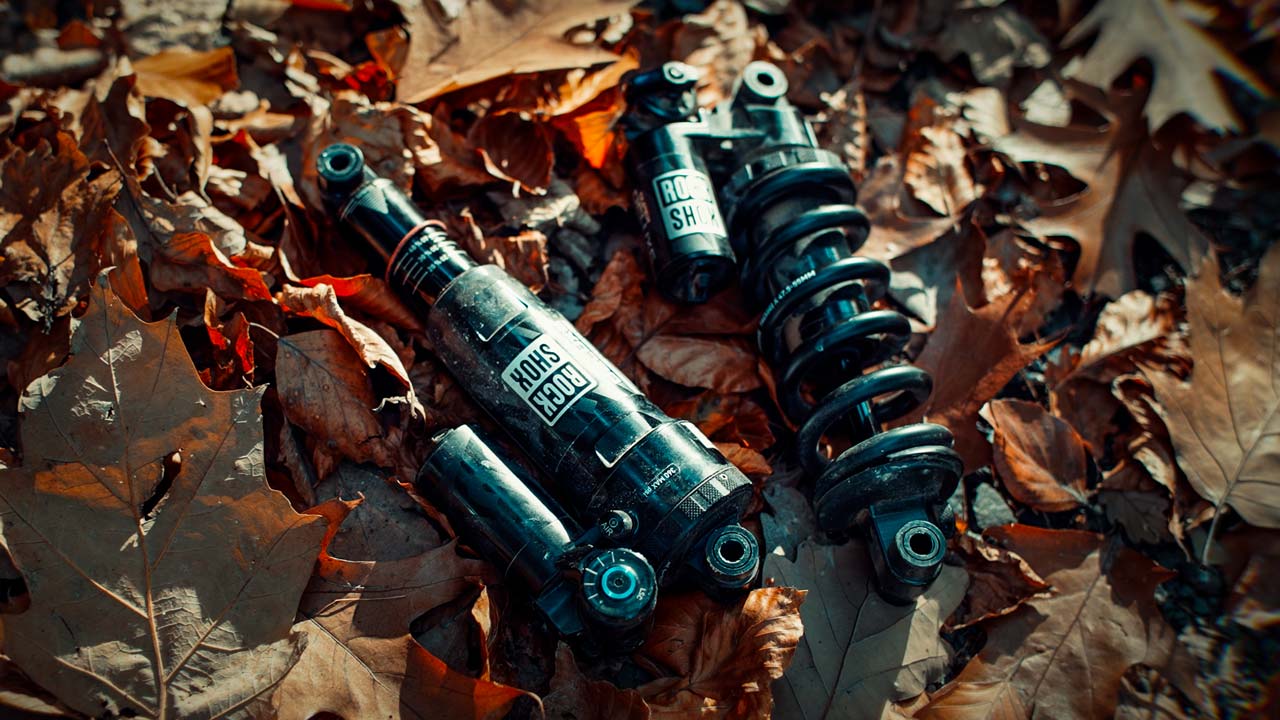Air vs Coil. In the form of two shocks that Rock Shox provided us with, we took a closer look at this topic. On the one hand the Rock Super Deluxe Coil, on the other the air shock. Opinions and preferences on the two types of shocks are divided. Over the last few months, we have been searching for the answer as to which of the two damper types is better. It was actually not that easy – more on that in a moment.
Air vs. Coil
The facts are these: coil shock absorbers enjoy the status of finer response, less maintenance and linear spring characteristics. For this, you first have to determine your spring rate and, if necessary, carry out a modification on the bike. In addition, the greater riding pleasure comes at the cost of additional weight. Air shocks, on the other hand, stand out for their variability, e.g. the easy weight set-up with the help of a high-pressure pump. They are also significantly lighter. But they are said to have poorer responsiveness.

In detail, the whole thing looks like this: With the air shock, you pump the desired PSI value into the cylinder, adjusted to your body weight. Up to 250psi fit into such an air cylinder. When the suspension compresses, the damper is squeezed and the air inside is compressed. The harder the impact, the more pressure is created. Ergo, more counterpressure. Due to the progressive function, every air shock absorber has a natural impact protection built in. At some point, the counterpressure is so high that there is no more room. So there is a lot of pressure in the tank. This requires a lot of technology and a lot of seals – which is one reason why certain situations with the air damper can feel uncomfortable or insensitive. Since there is a lot of pressure in the positive air chamber, it takes a lot of force to get anything moving. To support this, a negative air chamber presses against the positive chamber, so that less breakaway torque is required and the damper reacts more sensitively. This is where SRAM’s own DebonAir system comes into play, which is supposed to imitate the sensitive response of steel shocks.
The coil shock is more linear. Conservatively, you could say “you know what you’ve got”. In contrast to the air damper, the characteristic curve is linear. This means that the entire resistance of the spring works evenly and constantly. So even when the going gets rough or the impact challenges the depths of the damper – the steel damper is there. The steel damper also feels more sensitive because there are fewer seals and a spring has no breakaway torque.
And now, after about 3 months of testing? Well, we humans always have a certain bias (whether we like it or not). This is also the case with this damper. Let’s have a quick look at the timeline: We received this beautiful new part in August last year. Full of anticipation and zest for action, we gathered a lot of trail kilometres. In the sun, in the rain, in the bike park, on the local mountain, even at night. And then, after about 3 months of testing, we reviewed all our experiences. And that wasn’t easy at all. Because contrary to our expectations and previous experiences, as well as the stories we have heard and experienced about the two damper types, the result was not at all as expected.
Yes, the air damper is lighter, the steel damper heavier. Yes, the air damper is easier to adjust and the coil damper is more sensitive. Facts like these have remained unchanged. What has changed, however: These differences are nowhere near as serious as they once were.

Through the testing period, one big point has changed, or rather opened up: our preconceived opinion has softened. During our testing time, we moved from the head to the heart. From thinking to feeling. Especially when riding at night, where you see less and feel more, it became clear that the differences between the two dampers are not that great.
Phew, okay, admittedly it was getting a bit philosophical. What are we actually trying to say?
Well, there are still small but subtle differences. The steel shock allows you to rock a bit more aggressively over rocks and roots. The air shock is a little more poppy in curves and jumps and makes the ride feel a little lighter and literally airier – sometimes also a little more nervous. The coil damper is a little more sensitive and makes the bike and trailer experience seem a little more lively. The air shock is ready for use within seconds and you don’t have to find the right spring for your preferred weight.
BUT: I have a faint premonition that steel dampers could be superfluous in the future. In every respect. The technology is improving little by little. I’ve already had phases in the trailer experience where I just wasn’t itching for the reserves or sensitivity of the steel damper. Add to that, new technical advances, as well as electronics with paired apps for fine-tuning. The issue of sustainability will certainly be more than relevant in the future. If you do away with the springs, you also save material.


